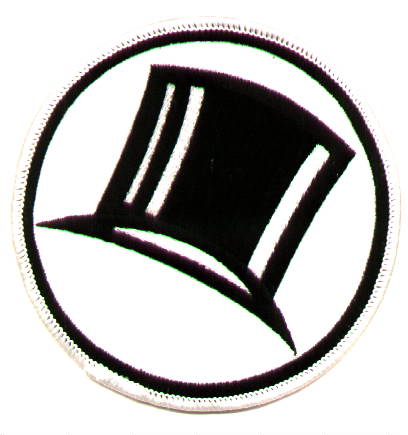

VF-14 Insignia Courtesy of Darryl Shaw |
VF-14 is the oldest US Navy squadron in existence, being able to
trace it's history all the way back to 1919, although many re-designations
occurred in the first twenty-five years. Before becoming VF-14 the
Tophatters were known by the designations VF-1, VS-41, VB-4, VA-1A, VA-14
and finally gaining the VF-14 title on the 15th of December 1949.
When first established as a Pacific Fleet Air Detatchment, in
September of 1919, the Tophatters flew the JN, or as it was more often
called the 'Jenny'.
During WWII VS-41 flew SBD-3 Dauntless torpedo bombers from the deck
of USS Ranger in the North African theatre during 1942. By November of
the next year the squadron had been redesignated once more, this time
becoming VB-4. Aircraft had also changed, now SBD-5 Dauntlesses were used
instead, this time to attacks against German forces in Norway. Late 1944
had seen a move to the Pacific theatre of war. Now flying SB2C Helldivers
off the carrier USS Bunker Hill the Tophatters fought in the latter
stages of the island hopping campaign. In 1945, for the last few months
of the war, they switched to the USS Essex and took part in actions over
Iwo Jima, Tokyo and Okinawa.
The high numbers of units involved in WWII meant that the Tophat
design was used by another squadron, VF-1, who flew in the Pacific
theatre for most of the war. Best evidence seems to suggest this was
simply due to confusion, the 'new' Tophatters being unaware that the
original squadron still existed. One of the most famous incidents in this
Tophatter's history occurred when Lt. Paul Pablo encountered a swarm of
Japanese fighters in the Bonin Islands. Having previously flown an entire
tour without seeing a Japanese aircraft the Lieutenant was understandably
anxious to meet the enemy. When he finally did it was a huge swarm of
fighters. Pablo was not heard from again, but his last transmission, "I've
already got four, and I've got thirty cornered" symbolises the fighter
pilot's credo, that only a spirit of attack will preveil. The 'new'
Tophatters were disestablished shortly after the war ended, leaving the
original squadron to carry on.
After the war the Tophatters received two changes of designation in a
short period of (as was the case for most Navy squadrons at this time, as
an effort was made to organise the rather chaotic numbering system).
VB-4, as the Tophatters had ended the war, became VA-1A in November of
1946, changing again to become VA-14 in August 1948. The final
designation change, to the present VF-14, occurred upon the 15th of
December 1949.
The redesignation to VF-14 coincided with the squadron's entry into
the jet age, and thus with their receipt of F3D Skynights. The
association with the Skynight was not to last long, however, F3H Demon's
arriving in the first months of 1950. VF-14 flew the Demo's for 13 years,
not relinquishing them unitl F-4B Phantom II's arrived in May of 1963.
Flying their new mounts VF-14 became the first Phantom squadron to
operate from the USS Roosevelt (not the present CVN-71).
1966 saw VF-14 become involved in the Vietnam war, whilst flying form
the Roosevelt VF-14 took part in 967 combat sorties and dropped 651,624
tons of ordnance.
For their next cruise, in 1968, VF-14 returned to the East Coast, flying
off the newest aircraft carrier, USS John F.Kennedy.
Receiving their first F-14s in September 1974, the squadron worked up for
it's first deployment as part of CVW-1 onboard USS John F. Kennedy (CV-67)
in the Mediterranean. The
cruise lasted from June 1975 to January 1976, the first time F-14A's had
been deployed with the Atlantic fleet. This was followed by two similar
deployments onboard Kennedy, starting in August 1980 and July 1981
respectively.
During the 1980 cruise VF-14 won the COMNAVAIRLANT (Commander
Naval Air Forces Atlantic) Battle "E" award for the second year in a row.
In June 1982, the squadron shifted to CVW-6 onboard USS Independence
(CV-62). In this and all subsequent deployments VF-14 was partnered by
VF-32.
In 1983 the squadron took part in two conflicts, firstly the US invasion of
Grenada,then the US airstrike on the Lebanon in December of that year.
On April 1st 1985 VF-14 was on the move again, returning to USS
John F. Kennedy, but this time as part of CVW-3. The year featured
some eventful deployments for the Tophatters, who took part in Red
Flag 85-4 during June. Red Flag is a world famous series of exercises,
the aim of which is to put pilots and planes in the most realistic
simulation of war that can be created within peacetime safety rules. Red
Flag has emphasised composite force tactics from the very beginning,
the aim being to integrate fighters, strikers, recon and transport
aircraft into a package that can work fluidly and well together. VF-14's
deployment probably consisted of a good range of interception and
strike escort missions. Two months later, in August, VF-14 took part in
it's annual FFARP (Fleet Fighter ACM Readiness Program), the first to
feature the F-21A Kfir as aggressor aircraft.
 |
| VF-14 markings from the mid to late 1980s |
 |
Today's VF-14 markings are much more subdued, if the triangle on the tail is carried at all it is only as a dark grey outline. The Tophat also tends towards dark grey. A dark grey tailcode is carried on the inner surface of the tails. The squadron's hi-vis aircraft are slightly more colourful, having the triangle in red and carrying the Tophat on a white background. VF-14 also has two aircraft that carry the 'Topcat' insignia with the legend 'Fighting 14' underneath.
[Main Page]
[F-14A]
[F-14B]
[F-14D]
[Tomcat 21]
[Atlantic Fleet Squadron Histories]
[Pacific Fleet Squadron Histories]
[F-14A Images]
[F-14B Images]
[F-14D Images]
[F-14 Model Kits]
[US Navy Air Wings]
[A-6 images]